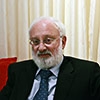The Theory Of Internal Contact Between People
 Question: What topics are there in the course “Evolution as Development of Egoism?”
Question: What topics are there in the course “Evolution as Development of Egoism?”
Answer: It encompasses absolutely everything. It will include: culture, communication, family, nationalities, civilizations, and the history of humanity from which one can draw a large amount of data and examples for our life today and for future states.
Knowing about yesterday, I can better understand what is happening today, and then can somewhat effect the future. Personally I am not a fan of history and geography, but we really should know history on the basis of the development of our egoism. It helps us understand how we are developing.
Aside from the courses, “Evolution as Development of Egoism” and “Freedom of Will,” the other courses will have more of a psychological quality. The first one, which lies between these two and a course in psychology, is on the perception of reality, meaning ontology or the theory of knowledge. It examines how we perceive the surrounding world, our five senses, the way this world is reflected within our five senses, and to what extent our perception is a consequence of internal states and properties of a person.
We study whether our perception is objective, and how we can influence it. Can we set such internal parameters for ourselves that would allow us to perceive this world from different angles, from different points of view, as if changing places and dwellings within one another? Say you see the world from one perspective and I from another, and then it’s as if we trade our points of view with each other.
In conversing with someone, we always want that the person to understand us. “Do you understand me? Can you imagine what I’m talking about? Did I express myself correctly?” That is, we are always concerned about proper communication. But it’s never there because we can’t “enter” another person and from within him take a look at the world. Until we can acquire the technique of emotional perception of each other, understand the properties and feelings of another, and see the world through his eyes, we will not understand one another.
The integral connection involves teaching all the people in the world to achieve that inner contact with each other, when one can substitute for another, when it’s as if I move into you and you into me. Then we’ll start to really understand one another.
We see this in a pairing of any two elements in nature. If there exists some element “I” within me, and there is some kind of “you,” then if we want to understand each other we must combine together all of your qualities and all of my qualities, as if mutually overlaying each other. That is, you perceive my qualities and can imagine your life and the world through them, and I through yours.
The same thing happens in technology. A similarity of two elements is required for their joining. And even though they are opposite from one another (say, one is convex and the other concave), still when we combine them, they must completely correspond to each other. That is, they must be adjusted and created in such a way that each has the shape of the other. This is where our correction lies: in this adjustment of fit towards one another.
This topic isn’t merely part of some theoretical course because it provides pure practical conclusions and work on knowing the world. Without it there is no communication. As well, it will be impossible to know the world without seeing it internally through each other. In practice, in our integration with all the people of the world, we must achieve such a state where I can “dwell” inside all the others, feel all of them, and through them perceive the world.
And when I do that in mutuality, as if plugging into them with my aspiration and disposition, I suddenly see a completely different world: multifaceted, amplified seven billion times, and simultaneously unified, that is, one whole while simultaneously composed from an enormous quantity of cells, like a honeycomb, because I look through each and every one. What takes place is an incredible picture of amplification of power for penetration into this world. This is true ontology, the practical theory of knowledge.
[64807]
From a “Talk on Integral Education” 12/12/11
Related Material:
Clarifications, Clarifications, Clarifications…
How Do You Understand A Japanese Person?
A Man Of The World







Discussion | Share Feedback | Ask a question